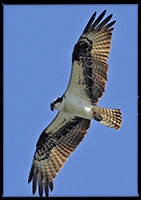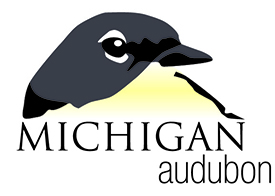Featuring: The Osprey
A conservation success story
Breeding GroundsA conservation success story
The Osprey requires large, open areas and calls most of Canada home during the summer months. Breeding ospreys are found as far north as Alaska, south to Washington and Oregon and east to Michigan and Maine.
Migration Range
Osprey can be found migrating through most of the US, Mexico and northern parts of Central America.
Wintering Grounds
This hawk winters on the coasts in Central America and throughout the entire South American continent, except the southernmost portions of Chile and Argentina.
Size & Shape

Ospreys are large hawks with a unique shape. Despite their size they have slender features, including long narrow wings and thin legs. The bird measures 21.3 to 22.8 inches in length with a wingspan of 59.1 to 70.9 inches and weighs around 3.1 to 4.4 pounds.
Coloring
Ospreys are whiter than most other raptor species, with white below and brown above. When soaring you can see the white underneath including the wings which have a prominent dark patch as the wrists (picture right, credit: Roger Eriksson). The head is white with a broad brown strip through the eyes.
Habitat
Unable to dive any deeper than three feet, Ospreys lean towards areas of habitat with shallow fish-filled water including rivers, lakes, reservoirs, lagoons, swamps and marshes. Nests are located now farther than 12 miles from accessible fish.
Food
These hawks are unique because they are the only hawk species to feed exclusively on live fish(fish make up 99 percent of their diet). They consume both fresh and saltwater fish that measure between 6-13 inches in length. They also get the majority of their water from eating fish. Osprey are excellent anglers, catching a fish on average every one out of four times, although some possess a 70% success rate.
Behavior
Ospreys are good at soaring and diving but are not as agile as other hawks. They are mostly solitary birds who prefer to roost alone but may be seen with a small winter flock of six to ten other Osprey. The hawk is not overly territorial and only defends the nest and immediate area rather than a larger territory. Males perform a “sky dance” for females in which they dangle their legs with a fish or nesting material alternating between soaring and slow, shallow wing beats. His performance can occur as high as 600 feet above the nest site and will last around 10 minutes.
Sound
For the size of the bird their calls are much less intimidating. Ospreys have high-pitched, whistling voices, sometimes similar to a whistling kettle.
Nests
Nest materials, including bark, sod, grasses, vines, algae, or flotsam and jetsam, are collected by the male and the nest is constructed by the female. In the first year the pair will usually construct a small nest less than 2.5 feet in diameter and only a mere three to six inches in depth. After generations of adding to the nest Osprey can have nests as large as three to six feet in diameter and 10-13 feet in depth. That’s big enough for a human to sit in!
Nest are found on snags, treetops or between large branches and trunks; on cliffs or human-built platforms. Many buildings now have Osprey Cams.
Conservation Status
Least Concern. However, this wasn’t always the case, populations plummeted in the early 1950’s to 1970’s due to pesticide positioning. Between New York and Boston along the east coast 90 percent of breeding pairs disappeared. In 1972, the U.S. banned the use of DDT (which made the Osprey’s egg shells too thin to incubate) and populations quickly recovered. Destruction of habitat also affected the hawk greatly such as the removal of trees and new developments along the coastline. Now specially constructed platforms have helped the bird’s population.
Interesting Facts
- During the Osprey’s 15-20 year lifespan they may log more than 160,000 migration miles. “During 13 days in 2008, one Osprey flew 2,700 miles—from Martha's Vineyard, Massachusetts, to French Guiana, South America.” (Cornell Labs)
- Osprey’s have a reversible outer toe, allowing them to grasps with two toes in the front and two behind. This is unusual among hawks.
- The average time the bird spends hunting for fish is 12 minutes with a above average catch rate.
- According to Cornell, “The name "Osprey" made its first appearance around 1460, via the Medieval Latin phrase for "bird of prey" (avis prede). Some wordsmiths trace the name even further back, to the Latin for "bone-breaker"—ossifragus.”
- The oldest known Osprey was 25 years and two months old.



No comments:
Post a Comment